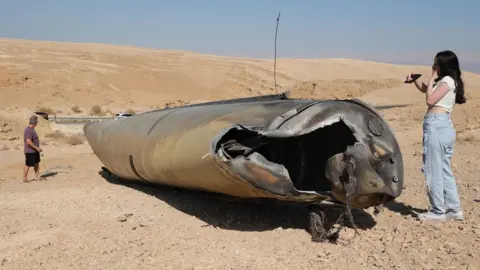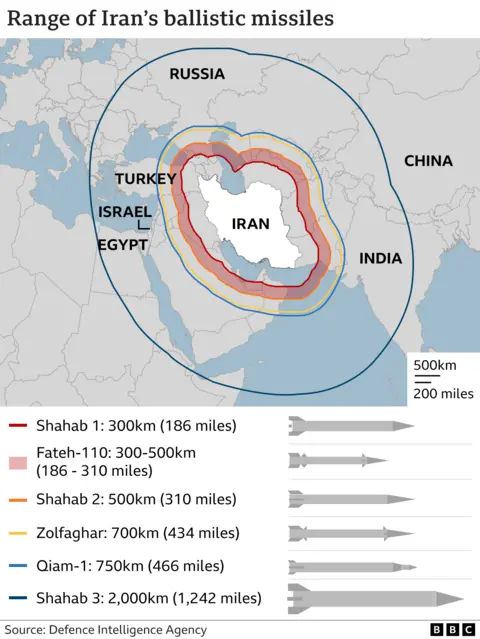How could Israel respond, and what might Iran do then?
 EPA
EPAThe Middle East is once again on the brink of a deep and damaging war between two protagonists that have been facing off against each other for much of the past 45 years. This is now one of the most dangerous moments for the entire region.
Iran, which became an Islamic Republic after the overthrow of the Shah in 1979, has long vowed to destroy the state of Israel, which it calls the “Zionist regime”. Israel accuses Iran’s Revolutionary Guards Corps (IRGC) of spreading violence across the Middle East through its allies and proxies, a view shared by several Arab governments.
Israel is poised to retaliate against Iran for Tuesday’s volley of ballistic missiles, some of which penetrated Israel’s air defences.
Iran says that was in response to two assassinations by Israel – of the Hezbollah leader Hassan Nasrallah in Beirut and of the Hamas leader Ismail Haniyeh in Tehran.
So what happens next?
Both Israel and its closest ally, the US, have vowed to punish Iran for launching 180 missiles at Israel. “Iran,” says Israeli PM Benjamin Netanyahu, “will pay a heavy price.”
The restraint that Israel’s allies urged on it the last time there was a standoff like this in April is more muted this time. And given Israel’s determination to take on all its enemies at once – in Lebanon, Gaza, Yemen and Syria – the Netanyahu government seems to be in no mood to hold back.
Israeli planners will likely now be debating not if and when to hit Iran, but how hard.
Aided by US satellite intelligence and by Mossad (Israel’s overseas spy agency) human agents on the ground in Iran, the Israel Defense Forces (IDF) has a wide range of targets to choose from. These can broadly be divided into three categories:
- Conventional military – An early and obvious target will be the bases from which Iran launched those ballistic missiles. So that means launch pads, command-and-control centres, refuelling tanks and storage bunkers. It could go further and hit bases belonging to the IRGC as well as air defences and other missile batteries. It could even try to assassinate key individuals involved in Iran’s ballistic missile programme.
- Economic – This would include Iran’s most vulnerable state assets – its petrochemical plants, its power generation and possibly its shipping interests. This, however, would be a deeply unpopular move in Iran as it would end up hurting ordinary people’s lives far more than any attack on the military.
- Nuclear – This is the big one for Israel. It is a known fact, established by the UN nuclear watchdog, the IAEA, that Iran is enriching uranium well beyond the 20% needed for civil nuclear power. Israel, and others, suspect Iran of trying to reach “breakout point” where it is within a very short timescale of being able to build a nuclear bomb. Sites on Israel’s possible target list include Parchin, the epicentre of Iran’s military nuclear programme, research reactors at Tehran, Bonab and Ramsar, as well as major facilities at Bushehr, Natanz, Isfahan and Ferdow.
A large part of their calculations will involve trying to second guess Iran’s response in turn and how to mitigate it. The Iranian position is that after launching those missiles at what it says were Israeli military targets on Tuesday the score is now settled. But it is warning that if Israel retaliates it will hit back in turn.
“This is only a glimpse of our capabilities,” said Iran’s President Masoud Pezeshkian. The IRGC reinforced this message, stating: “If the Zionist regime responds to Iran’s operations, it will face crushing attacks.”
Iran cannot defeat Israel militarily. Its air force is old and decrepit, its air defences are porous and it has had to contend with years of Western sanctions.
But it still has an enormous quantity of ballistic and other missiles as well as explosive-laden drones and numerous allied proxy militias around the Middle East. Its next volley of missiles could well target Israeli residential areas, rather than military bases. The attack by an Iran-backed militia on Saudi Arabia’s oil facilities in 2019 showed just how vulnerable its neighbours are to attack.
The IRGC Navy, which operates in the Gulf, has large flotillas of small, fast missile attack boats which could, potentially, overwhelm the defences of a US Navy 5th Fleet warship in a swarm attack. If it had orders to do so, it could attempt to sow mines in the Strait of Hormuz, interrupting the flow of up to 20% of the world’s daily oil exports, something that would have a major impact on the global economy.
And then there are all the US military bases, dotted up and down the Arabian side of the Gulf, from Kuwait to Oman. Iran has given warning that if it is attacked it won’t just hit back at Israel, it will target any country it perceives as supporting that attack.
These then, are just some of the scenarios that defence planners in Tel Aviv and Washington will now be considering.







